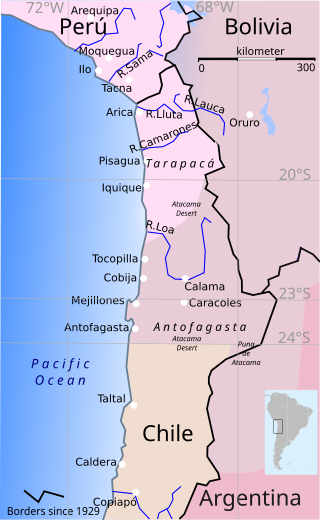
The War of the Pacific, also known by multiple other names, was a war between Chile and a Bolivian–Peruvian alliance from 1879 to 1884. Fought over Chilean claims on coastal Bolivian territory in the Atacama Desert, the war ended with victory for Chile, which gained a significant amount of resource-rich territory from Peru and Bolivia.
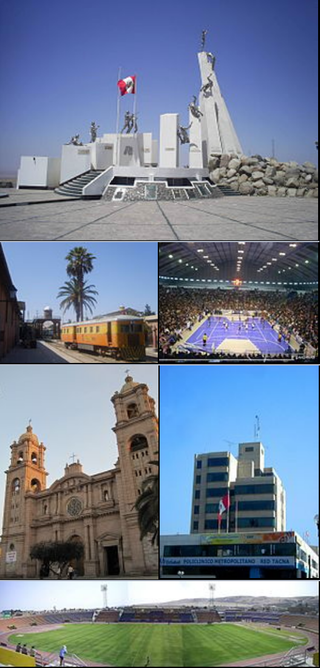
Tacna, officially known as San Pedro de Tacna, is a city in southern Peru and the regional capital of the Tacna Region. A very commercially active city, it is located only 35 km (22 mi) north of the border with Arica y Parinacota Region from Chile, inland from the Pacific Ocean and in the valley of the Caplina River. It is Peru's tenth most populous city.
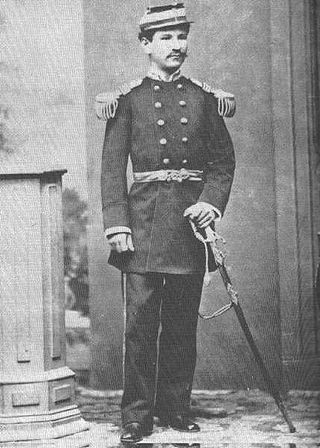
Alfonso Ugarte was a Peruvian civilian turned military commander during the War of the Pacific, between Peru and Bolivia against Chile. He held the rank of colonel.

Francisco Bolognesi Cervantes was a Peruvian military colonel. He is considered a national hero in Peru and was declared patron of the Army of Peru by the government of Peru on 2 January 1951.
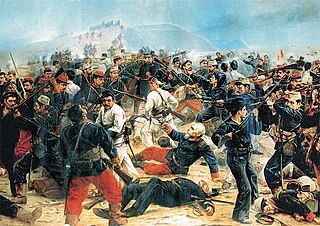
The Battle of Arica, also known as Assault and Capture of Cape Arica, was a battle in the War of the Pacific. It was fought on 7 June 1880, between the forces of Chile and Peru.

Justiniano Borgoño Castañeda was a Peruvian brigadier general and politician who served as the 29th President of Peru, an office he held for four months. The son of a brigadier general in the Peruvian Army, Borgoño left behind agricultural administration to join the Army following the outbreak of the Peruvian Civil War of 1856–1858. He returned to military service nearly twenty years later to serve in the War of the Pacific, during which he survived a leg wound and being taken as a prisoner of war for three months.
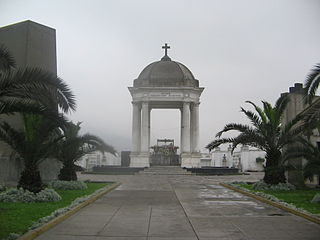
Presbyter Matías Maestro Cemetery, formerly the General Cemetery of Lima, is a cemetery, museum and historical monument located in the Barrios Altos neighbourhood of Lima District, in Lima, Peru. Inaugurated on May 31, 1808, it was the first pantheon in the city since burials were previously held in the city's churches. It was named in honour of its designer, Spanish priest Matías Maestro.

After the naval campaign of the War of the Pacific was resolved, the Chilean terrestrial invasion began.
Tacna Locomotive park, is a park, located at the Alameda Bolognesi, in the centre of the city of Tacna, Peru. It features a 19th-century train that carried Francisco Bolognesi and his troops to the defence of the Morro de Arica during the War of the Pacific.

José Juan de Dios Mateo Osbaldo Botaro Lepiani Toledo was a Peruvian painter. He is primarily known for historical and patriotic scenes; notably those related to the War of the Pacific.

The Plaza Bolognesi is a roundabout located in the Lima District and the Breña District, in the capital of Peru. It is located at the intersection of Brazil Avenue, Arica Avenue, Alfonso Ugarte Avenue, Guzmán Blanco Avenue, and 9 December Avenue.

The Lima campaign is the third land campaign of the War of the Pacific, carried out by Chile between December 1880 and January 1881. The campaign ended with the Chilean occupation of the Peruvian capital and the establishment of the Chilean authority in it and other surrounding territories, which would extend until 1883, with the end of the war.

Martiniano Urriola Guzmán was a Chilean colonel of the War of the Pacific. He participated across many campaigns of the war as well as being one of the primary commanders of the Chilean North Operations Army.

Gloria del Pacífico is a 2014 Peruvian epic war historical drama film written, directed and produced by Juan Carlos Oganes as his twelfth film. Starring Reynaldo Arenas, Carlos Vertiz, Gustavo Mac Lennan, Lilian Nieto, Pold Gastello, Juan Manuel Ochoa and Paloma Yerovi. It is the first part of a trilogy that will relate what happened during the War of the Pacific between Peru and Chile, which occurred in 1879 and 1883. The film premiered on November 6, 2014, in Peruvian theaters.

La respuesta, also known as La respuesta de Bolognesi, is an 1891 oil painting by Peruvian painter Juan Lepiani. It forms part of the collection of the Combatants of the Morro de Arica Museum.

El último cartucho is an 1899 oil painting by Peruvian painter Juan Lepiani. It forms part of the collection of the Combatants of the Morro de Arica Museum.

Jirón Caylloma, also known as Jirón Cailloma, is a major street in the Damero de Pizarro, located in the historic centre of Lima, Peru. The street starts at its intersection with Jirón Conde de Superunda and continues until it reaches Jirón Quilca.

Juan José de la Cruz Salvo y Poblete was a Chilean soldier who fought in the War of the Pacific as a Sergeant major. He is best known for being the envoy sent by the Chilean Army to the headquarters of Francisco Bolognesi's garrison in Arica to request his surrender after the allied defeat at the Battle of Tacna, to which Bolognesi replied by saying he would "fight until the last cartridge is spent".
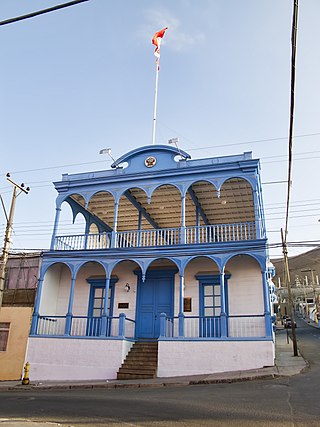
The Casa Bolognesi, also known as the Casa de la Respuesta, is a historical building owned by the Peruvian State located in Arica, Chile. It is the site of a meeting that preceded the Battle of Arica during the War of the Pacific.

María Graña Ottone Friendship Park is a public park located at the intersection of Alfredo Benavides and Caminos del Inca avenues, in Santiago de Surco, Lima, Peru. It features a monumental arch based on the one that once stood at Arequipa Avenue, in Lima District.




















